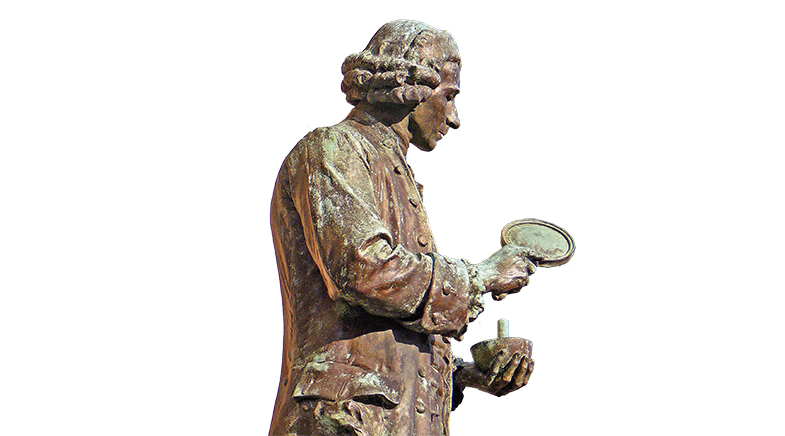The minister and the mouse
-
- from Shaastra :: vol 04 issue 05 :: Jun 2025

In the late 1700s, a radical English thinker discovered the presence of oxygen in the air.
Joseph Priestley gently lifted the inverted glass jar on his table and slid a mouse inside. Inside the jar was a new type of "air" that he had trapped from burning a clump of mercuric oxide using sunlight and a magnifying glass. He calculated that the mouse would probably live for 15 minutes until the air supply ran out. Surprisingly, it not only stayed alive for half an hour, but was also quite "lively and vigorous" afterwards. Another mouse survived for at least 45 minutes.
When Priestley (pictured) breathed in the trapped air, his chest felt "peculiarly light and easy". He also noticed that glowing wood "sparkled" and candles burned strongly in that air. In 1775, a year after he began these experiments, he wrote: "... in time, this pure air may become a fashionable article in luxury. Hitherto only two mice and myself have had the privilege of breathing it" (bit.ly/priestley-luxury).

Born in Yorkshire, England, in 1733, Priestley was a minister of the Unitarian faith, which eschewed the holy trinity of Christianity. He also made important scientific observations. Urged by American inventor Benjamin Franklin, he wrote a book on the history of electricity. He also suggested that the electrical force between two charged objects reduces with the distance between them; this later became the famous Coulomb's law in electromagnetism.
IN THE CROSSFIRE
Priestley emigrated to the U.S. to escape politics, only to land in the middle of a rivalry between John Adams and Thomas Jefferson. He was friends with both, but when Adams became the second U.S. President, Priestley criticised (bit.ly/priestley-politics) his policies. Adams’s supporters called for his deportation. Adams lost the next election to Jefferson, whom Priestley backed.
PHOTO: WIKICOMMONS

In 1767, he became a minister at Mill Hill Chapel in Leeds, and happened to live next to a brewery. Noticing that carbon dioxide gas was being vented out from the facility, he trapped the gas and bubbled it through water, thereby inventing soda water (bit.ly/priestley-soda).
Priestley strongly believed in the phlogiston theory – the idea that burning objects and rusting metals released a mysterious substance called phlogiston into the air. His ideas clashed with those of French chemist Antoine Lavoisier, who was also studying gases. Lavoisier found that rusting metals actually gained weight and argued that they must be absorbing something from the air instead, as were burning objects. When Priestley travelled to Paris in October 1774, he informed Lavoisier of his glass jar experiments. Lavoisier then realised that the "something" was probably a separate element in atmospheric air, which he later named oxygen.
Both Priestley's and Lavoisier's work showed that atmospheric air was not a single entity but a mixture of gases like oxygen. Unlike Lavoisier, however, Priestley firmly clung to the phlogiston theory till the end. He argued that the "pure air" he had separated lacked and therefore craved phlogiston, which is why it supported combustion more strongly. Ultimately, Lavoisier's views prevailed, and the phlogiston theory petered out.
PATIENT TEACHER
Priestley's real passions were preaching and teaching. He could do neither at Christian institutions, but got to teach at Daventry. He was the kind of teacher who chatted with students over tea and encouraged open discussions. A student once wrote (bit.ly/priestley-teacher): "I do not recollect that he ever showed the least displeasure at the strongest objections that were made to what he delivered...."
PHOTO: WIKICOMMONS

In later years, Priestley became notorious for his radical views on religion and free will, which made him at one point the most hated man in Britain. He rejected prevalent Christian traditions and voiced his support for the French and American revolutions, earning the nickname "Gunpowder Joe". In 1794, when an angry mob burned down his house and church, Priestley fled with his family to the U.S. and lived in rural Pennsylvania until he died in 1804.
Ranjini Raghunath is a Bengaluru-based science writer and editor.
Have a
story idea?
Tell us.
Do you have a recent research paper or an idea for a science/technology-themed article that you'd like to tell us about?
GET IN TOUCH














